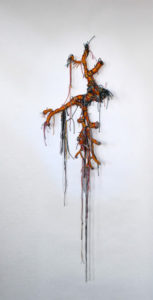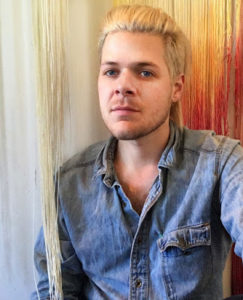This post was originally posted on March 15, 2017 to CAA’s old blog. Daniel is currently featured in our October 2018 Small Group Show – Creature Comforts! See Daniels work in person through November 2, 2018 at Kathryn Schultz Gallery!
Daniel Zeese
This weeks highlighted CAA Member is Daniel Zeese. His work is currently featured in the Creature Comforts exhibition that is up until November 2nd in our Kathryn Schultz Gallery.
What are your earliest memories of being artistic? Creating has always been a part of my life. I can’t pinpoint the details of my earliest memories of being artistic but I am sure they are at this craft shop in Upstate New York where I learned how to work with clay, glass, textiles and metals. I remember in elementary school making a sort of flip-book-poster hybrid, using highlighters and marker, of my house transforming from winter to spring. I am sure I tried throwing it away a bunch of times, but it is what my mother considers my first real piece of art so she always took it back.
When did art become a pursuit? Again, I am not sure. I went to school for sculpture, but I don’t think it became a “pursuit” until much later. I have always been making things. I had always been able to stop one thing I am doing and start making art. In the last three years, I have had to “pursue” making art for myself again. I had been making things the whole time here and there but not in routine, it had been a while since I had made something not for school, not for someone else, but for myself. I always come up with ideas at the most inopportune times, but finally I decided that I should drop what I was doing and start making art.
Are you self-taught or formally educated in visual art? I got my undergraduate degree in sculpture at Virginia Commonwealth University and a masters of architecture from The Boston Architectural College. I think I was self-taught before then, but a lot of it has been a learned experience.
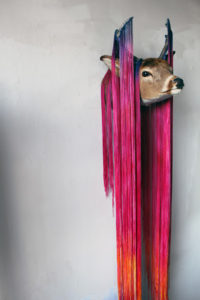
How did you first become involved with CAA? I went to a show that my good friend of mine, Mia Cross, had a painting in. I had seen pictures of her work before, but I wanted to see it in person. I stopped by an opening on my way home with work, and registered that night.
In what other ways are you involved in the local art community? I have been working with art in the public realm since moving to the area in 2010. My introduction to art here was with Carolina Aragón on her Flocks installation between Inman Square and Lechmere Station. I have also been worked on installations for a large-scale fiber artist on many projects locally and internationally. I have my studio at 20 Vernon street where I participate in open studios, and I have been teaching at the Boston Architectural College.
What medium do you currently work in and how did you choose this medium? Recently my work has been mainly fiber arts. I started making these small fringes at home. Once I had made about two dozen, I realized that the size of my work space was holding me back from making work the at the size I wanted to be making it. Coincidentally a good friend and painter, Paul William, told me he was looking to share a studio space. I took the opportunity and moved from the scale of my hands to the scale of my body. The other major element in my work has been taxidermy. Once I had these large-scale fringes hanging on the wall, it became clear that was wanted to become three dimensional and tell a story beyond being a textile wall hanging.
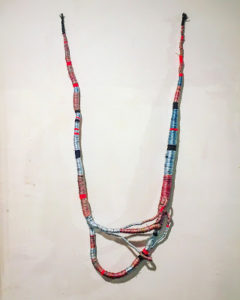
What is your creative process? I like to abuse a material. I want to see everything I can do with it before settling on how I will use it. Currently that material is nylon. I have made fringe before, but never at the scale I am making it now. I love the tactile quality of it. How people come into my studio and they touch it to feel its weight and see it move. Most of my process is reactional. I work best when I approach a new piece with an image in my mind of it but knowing in the end it will be completely different. The process seems monotonous but I am constantly making decisions. And I am layering those decisions over time. Dyeing the threads on the bobbins, knotting the threads into the fringe, creating patterns with the threads, washing it out, re-dyeing, trimming, re-dyeing, hanging it on the wall or on a dear, trimming it and probably re-dyeing it again.
Recently I was cleaning up my studio for a visit and swept a large pile dyed trimmed scraps. Now I am using them in a different body of bound works, and all that layering is coming through in completely different ways.
How do you choose your subject matter? Is there a reoccurring theme that carries throughout your work? Once I started making fringe I really started thinking about that word. What it means to be on the fringe of a place. To be the membrane that defines what is inside and what is outside of what is considered acceptable by the greater society. That is where the dear come in to play. They are a thing that we marvel at from a distance, but when are approached by them, or they come into the city, they are feared and misunderstood. They are seen as not belong here. This resonates with a history I have witnessed within urban areas. The work is trying to humanize the misunderstood. To glorify them. To give them identity. To dress them as if they can be on this side of that membrane without fear or confusion.
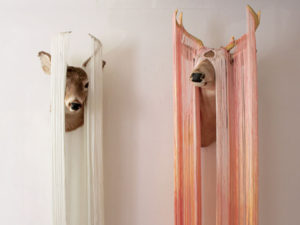
What is one of your artistic goals? Make something bigger and make something smaller.
What living artists are you inspired by? I am most inspired by my former teacher Elizabeth King. Her commitment to teaching and practicing was inspiration enough, but I could spend a lifetime looking at her work. Her studio opened my eyes to a life goal I never knew I had before witnessing it. I can always tell if something I am doing is worth it if it is her voice in my head speaking back to me. I should tell her that.
Do you own any art by other artists? I mentioned two, Paul William and Mia Cross. I am always looking for more art… and more wall space.
